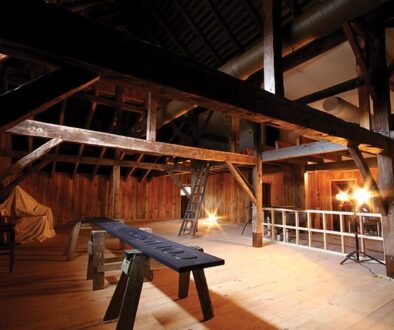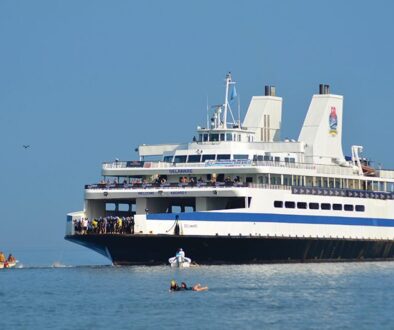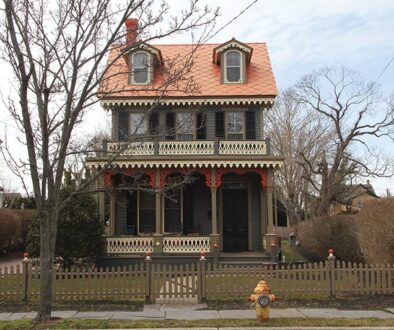The horse you rode in on

Horses have always been among the most beloved of domesticated creatures. Regal, proud, majestic, as well as utilitarian, and possessed of distinct personalities and high intelligence, horses are one of the most prized and cherished of our four-legged friends.
Cape May County is no different in enjoying this romance with the equine, dating back to Cape Island’s first visitors, the Lenni Lenape tribe, who would travel by canoes and horses to fish and vacation here as early as the 17th century. One can hear the echoes of days gone by as the horses and carriages of Cape May Carriage Company carry visitors and residents through the streets of Cape May. Established in 1983, the Carriage Company transports one into the past, when life’s pace was slower, carriages were adorned, and the horses were high-stepping.
But it was during the first half of the 1800s when the horse played an especially predominant role in Cape May County’s financial growth.
Prior to the train, trips to South Jersey were made by horse-drawn carriage or stagecoach, a long, arduous journey which often took two days along bumpy, dusty dirt roads. The railroad not only brought much-needed necessities to the region, but also new families wanting to settle here and vacationers wanting to enjoy the beaches and fresh sea air. With this influx came—as far as Cape May County politicians were concerned—the need to provide amenities.
Seaville was a crossroad community to Beesley’s Point, Ocean View, Dennisville, and Petersburg. It became a major train stop, and South Seaville jumped at the opportunity to profit. In 1863, the town established the Seaville Methodist Camp meeting grounds, a fairground, and one of the first horse racing tracks in the county.
The area flourished so quickly that South Seaville residents rallied for moving the existing government seat from Cape May Court House to South Seaville. This angered the residents of Court House so deeply that they established their own fairground and racetrack just to the north, where another rail stop was established the same year on lands owned and later donated by the Swain family for a train station called “Swainton.” Though it is not known for sure, this may well be the 4-H Fairground which still exists today. In any case, Swainton quickly put an end to the popularity of South Seaville’s attractions.
In 1866, entrepreneur Joseph Heis, a stable and hotel owner, purchased a racetrack area between Town Bank and Cox Hall Creek. The next year, the Diamond Beach Park and Hotel Association—under the auspices of John West and Aaron Miller, owners of the United States Hotel on Cape Island—purchased the land from Heis and built an oval mile-long racetrack and a clubhouse. The first sulky races were held there late that summer.
The third racetrack of historical note was built just west of Cape May City, in Eldredge, which was incorporated into the Borough of West Cape May in 1884. Theodore M. Reger, a Philadelphia land speculator, Thomas H. Williamson, and Albert B. Little started the Neptune Land Company in 1882 in order to develop the site of the former Mount Vernon Hotel destroyed in a fire in 1856. This piece of land extended from the Sea Breeze Excursion House westward toward the Cape May Lighthouse, and from Beach Avenue to Cape Island Turnpike, now Sunset Boulevard.

Reger, along with partner James Henry Edmunds, founded the West Cape May Improvement Company to develop streets and lands. Edmunds became quite the political figure in both West Cape May and Cape May City, serving as Cape May’s mayor from 1885 to 1892 and 1895 to 1896. In 1886, he also purchased the county’s oldest newspaper, the Cape May Wave, and turned it into the voice of the local Democratic Party. Edmunds had the goal of furthering the lower end of the state by building the Cape May Driving Park Company. It was to be an oval horseracing tract in the area bounded today by Columbia Avenue, Fourth Avenue, Sunset Boulevard, and Stevens Street, 80 acres in total. Edmunds promised the community a “splendid” grandstand would be built, accommodating 3,000 people, and from which one could see Cape May City, the ocean, and Cape May Point. Edmunds also promised that soon a railroad spur from Cape May would connect the two. The driving park would feature a lake in the center, complete with swans and aquatic fauna, a jockey’s clubhouse, and cricket and baseball fields, as baseball was becoming all the rage of the era.
Very soon, a feud broke out between the Star of the Cape and the Cape May Wave, with editorials by the Republican City Council denouncing the racing track as a sordid place for gambling and drinking.
Edmunds pushed ahead, and on Saturday, July 28, 1888, the racetrack opened. One hundred thoroughbreds vied in four races that day. Imagine the scene: every carriage in town was used to transport the fans, including well-dressed ladies, no doubt with fancy hats and fans in hand. It was said the betting was “lively” and even “spiritedly wild” at times.
The Atlantic Journal reported, “It is stated that the season at Cape May will open earlier than usual next year, on account of the race course. Several New York gentlemen have made purses to the amount of $60,000 for the early spring races. This is where Atlantic City has permitted Cape May to get ahead of her.” The Pennsylvania Railroad even scheduled special rail service between Philadelphia and Cape May on the days of the races.
Although the train began the Cape May County commercial boom, it also meant the demise of the Cape May Driving Park. The promised spur from Cape May City to the racetrack was never built. Baseball replaced the excitement of horseracing, and the politics of the day had many Cape May residents frowning on the whole endeavor. Two summers later, with attendance dwindling, the racetrack in West Cape May shuttered for good, closing another chapter in the saga of horses on Cape Island.
For years after, a vague outline of the racetrack could be seen from the air. But West Cape May still remains an agricultural mecca, where horses play an integral part.
“My house is built on the western side on the site of the old racetrack,” George Rea, Sr., who lives on Third Avenue in West Cape May, says. “It’s a proud part of our history. My second cousin, Carol Flynn, also lives on the same site, across the street.” Says Carol, “It was always a great place. It’s one of the highest points in West Cape May. I’m not sure if it was the site of the grandstand. It may well have simply been a dumping area for the dirt from the construction site. Either way, it’s a great view. When I was a little girl I would climb up and play in the field there. In fact, my son Tyler did a project for school on the old racetrack. So its memory lives on, even with our kids.”
Carol Flynn’s family home, on the corner of Fourth Avenue and Stevens Street, dates to 1730. Her father, Les Rea, a third-generation farmer, has been working the land his entire life. His wife Diane says, “Though there were several owners through the years, Les’ father bought the land back. Though Lima beans were our big commercial industry, we also had horses for years.” Carol Flynn remembers this well. “My grandfather, Leslie H. Rea, raced the sulky, and my father had sulkies, as well as pacers and trotters. I’ve ridden for years. One of my fondest memories of growing up was when my grandfather took us to Dover Downs to watch the sulky races. We’d take the ferry across to Delaware, which just added to the fun. A very fond memory.”
Very near to the Rea Farm, Hidden Valley Ranch on Bayshore Road is the oldest riding stable on the island. Originally part of the Taylor Farm, it still sits on a large lot of the Taylor family ground. Fifty years ago, owner Mary Ellen (Taylor) Dickinson sold the horse farm’s land to the State of New Jersey under a land management agreement, whose terms provided the land would never be developed. Housing horses and offering riding lessons and summer camps was, and remains, its core function. Through the years, many visiting and local children and adults have ridden under the tutelage of proprietor Nancy Hall and various other instructors.
Stacy Alexander-Nevells, who grew up in Cape May, rode at Hidden Valley for 11 years. “I lived for riding,” says Stacy, now 34. “It took a lot of self-discipline and hard work. While my friends were sleeping away, at 3:30 in the morning, I’d be loading up to travel to horse shows. But riding was a great foundation for the rest of my life.”
Stacy’s life so revolved around horseback riding that she qualified for the famed Devon Horse Show in Pennsylvania, where she finished as the Reserved Champion. She also won the Hampton Classic in New York State in 1996, one of the largest outdoor horse shows in the nation. An injury forced Stacy to give up competitive riding in 2010 but she doesn’t regret it. “If I had a chance to do it again I would absolutely do it in a heartbeat.” Today, her 13-year old daughter, Nadia, has followed in her mother’s foot (or should we say, hoof) prints. “I encouraged her but didn’t force her to start riding but she wanted to. I’m very proud of her. My life was all about horses.”
Less than a mile away, Sea Horse Farm on Seashore Road in Cold Spring offers year-round English riding lessons for all abilities, from age five to adult. With a stable of 15 lesson horses, it creates a perfect environment for learning to ride. Sea Horse Farm also encourages students to learn how to take care of horses, including safety, how to properly tack and un-tack a horse, as well as understanding equine body language.
Ginna Riker taught at Hidden Valley Ranch for years with her sister Nancy before moving her lessons to Sea Horse Farm. “I taught at Sea Horse for more than 12 years with English Hunters,” she says. “It’s a wonderful farm. With its location, one minute you can be riding and the next be on the beach. I loved the kids and horses, and teaching everyone to understand horses.”
Green Acres Farm / Horsemanship4Life is the newest stable on the island. Situated on New England Road, close to Higbee Beach, it offers a different style of instruction based on the Parelli Natural Horsemanship, which teaches people to focus on horse behavior as well as horsemanship skills. Riders learn to observe and understand nonverbal expressions of the horse. Green Acres Horse Farm was created by Linda Steinberg, a self-proclaimed “mid-life crisis equestrian and life-long learner.”
Linda, from Bucks County, Pennsylvania, has been around horses her entire life, and started coming to Cape May in 1987, when she met her husband Howard and began riding lessons at Sea Horse Farm. When her life circumstances became somewhat more complicated, Linda decided she needed to do something meaningful. “I told Howard I needed my own horse,” Linda says. “I wanted to be able to play with it, which I couldn’t do at the stable.” Green Acres Farm is named for her husband’s love of the Green Acres television show, but the name fit right in with their circumstances in finding land. In March of 2015, Green Acres opened its stables to the public with the help of a friend who owned her own horse farm.
“This farm teaches riders that a horse isn’t a machine. Often people can’t relax, expect too much out of the horse, and don’t understand horse behavior. This method teaches that you must have a personal relationship, and the best part of the program is how both the person and the horse benefits. It changes your life. I needed something to see me through. The amazing revelation was how I changed. I’ve relaxed. I listen first, then react. My marriage is better. I’m a different person because of this.”
There has never been a time in the history of Cape May when horses haven’t been present. It’s what you get in a historic seaside community, rooted in farming, that has always catered to the public’s need for recreation and serenity.










